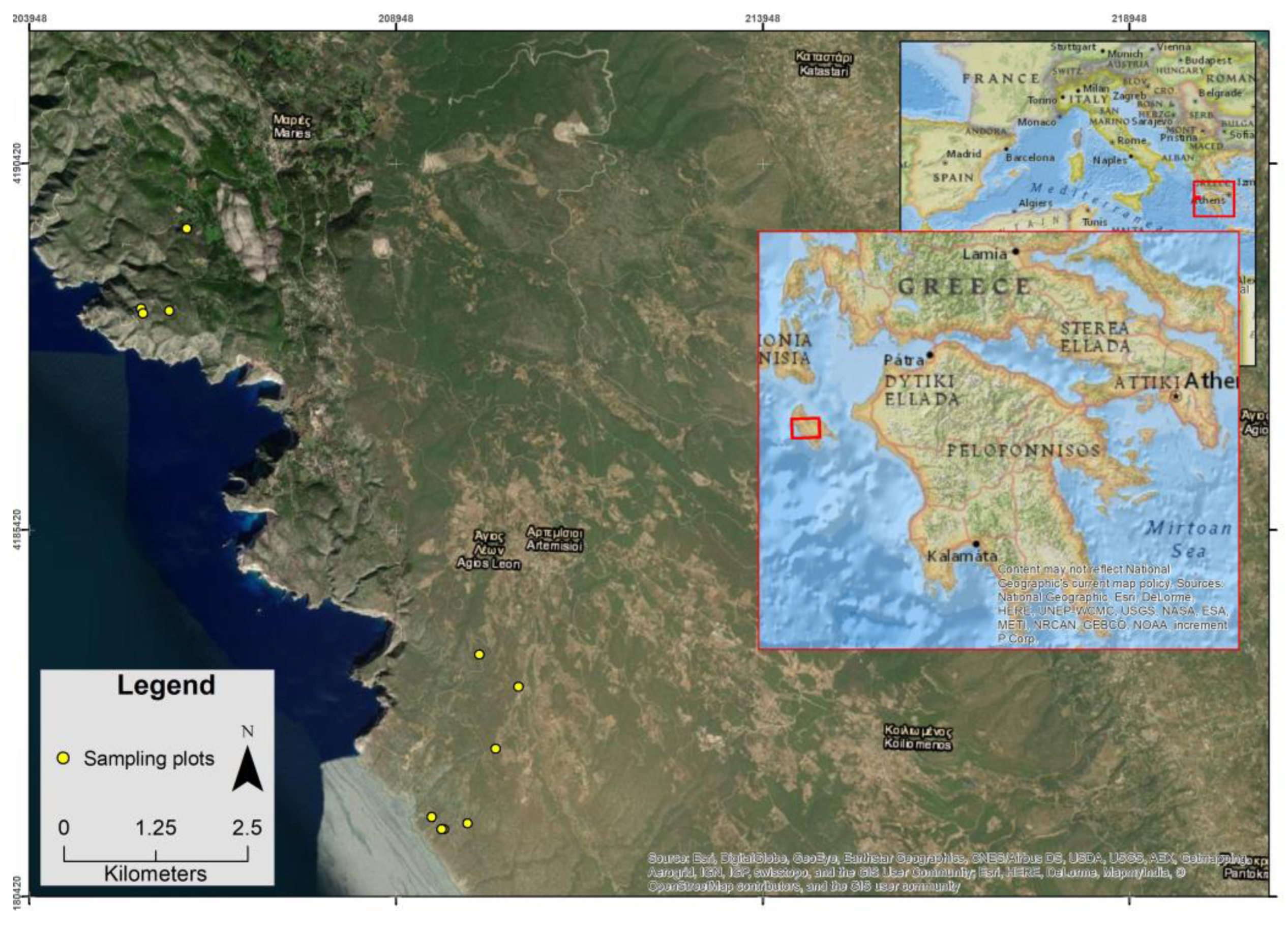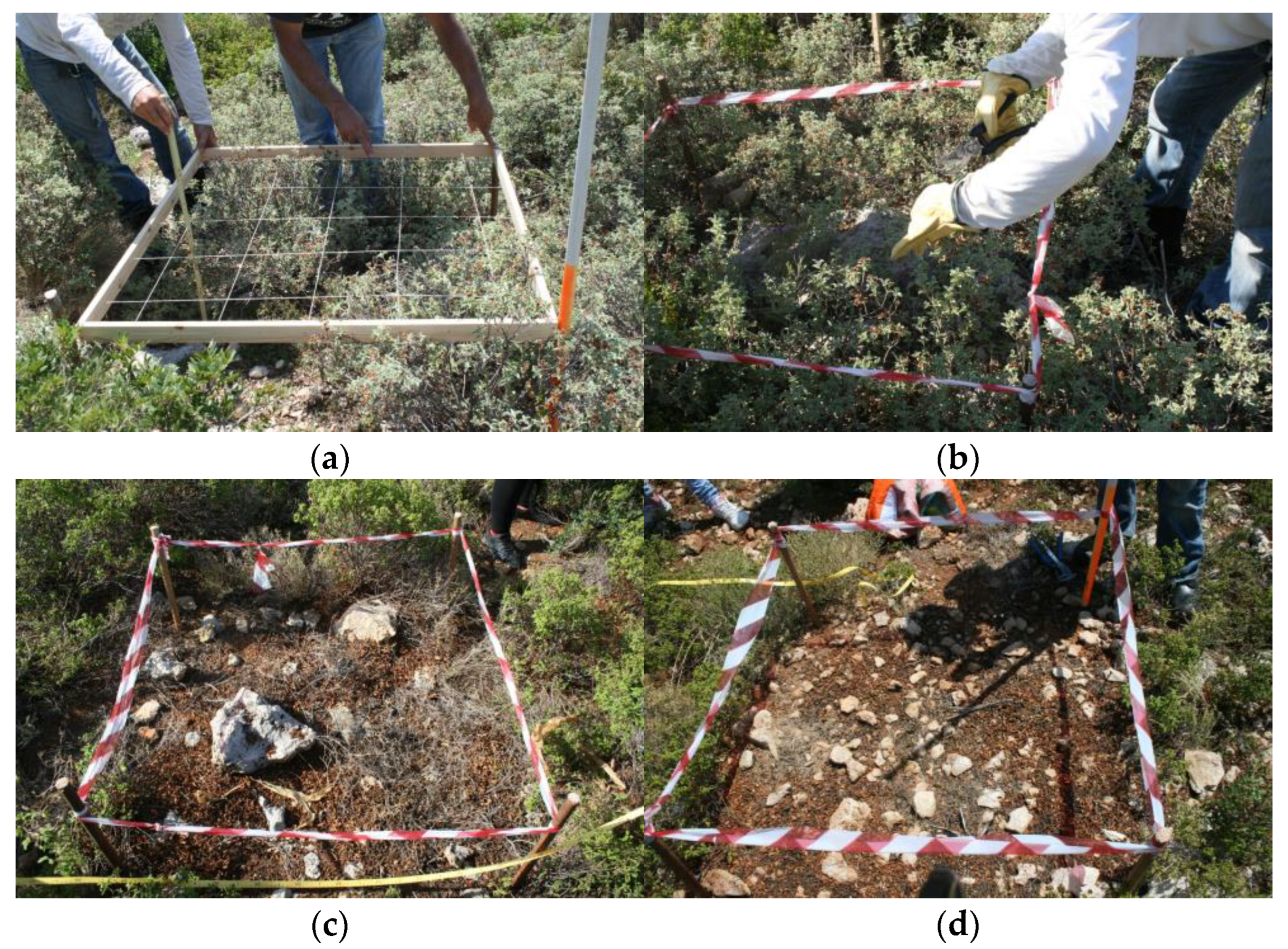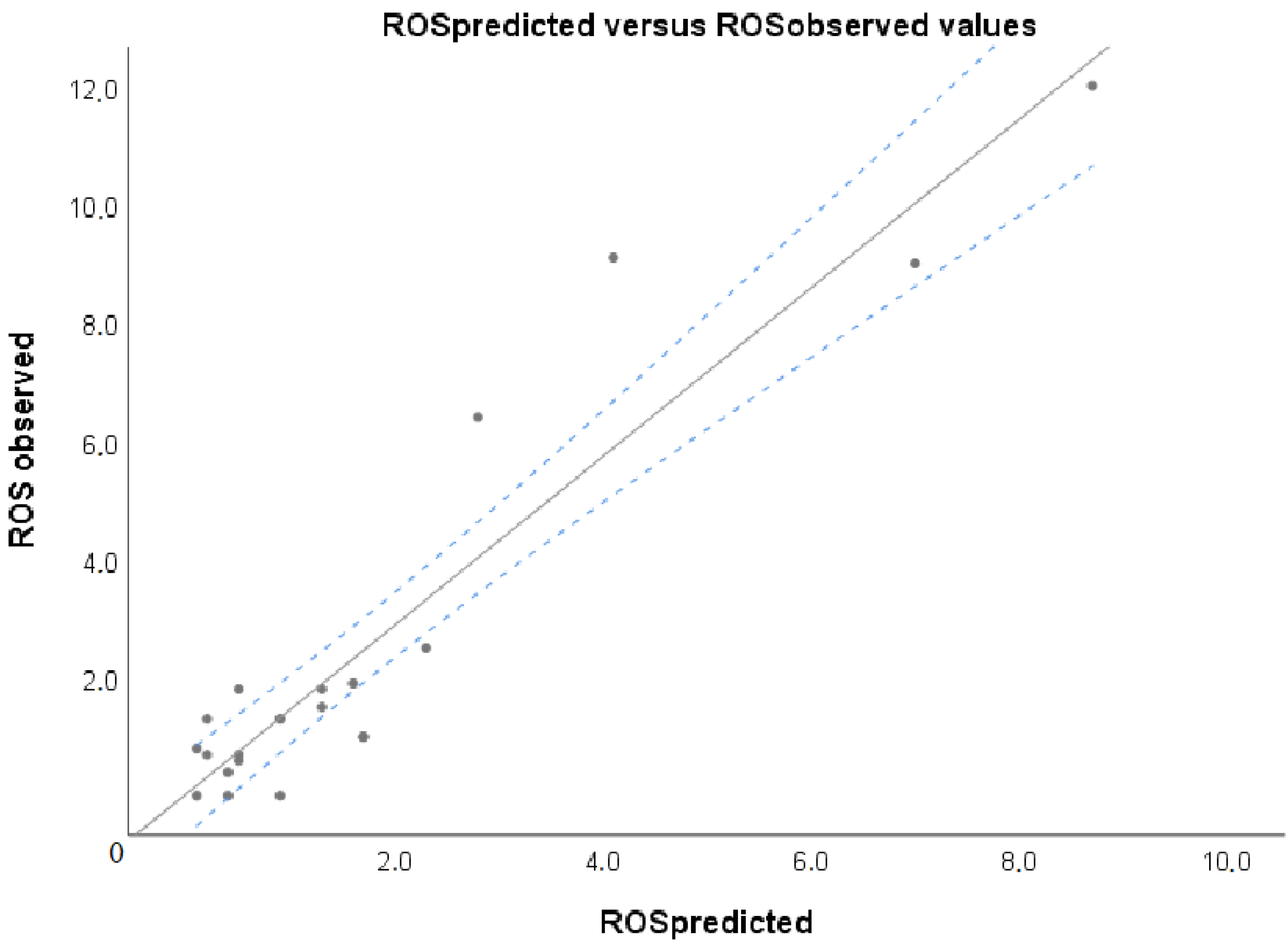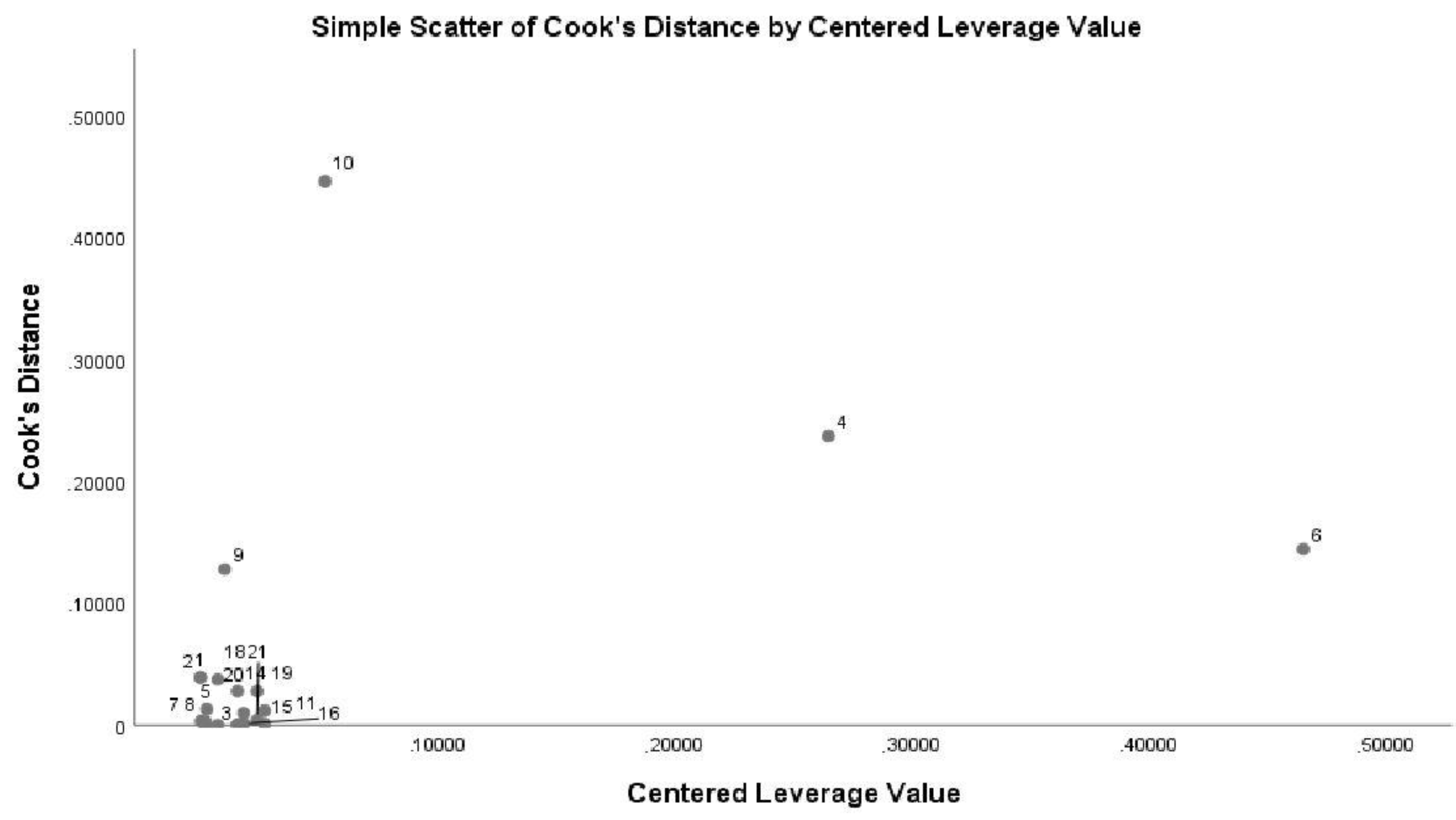Development of a Fuel Model for Cistus spp. and Testing Its Fire Behavior Prediction Performance
Abstract
1. Introduction
2. Materials and Methods
3. Results
4. Discussion
5. Conclusions
Author Contributions
Funding
Institutional Review Board Statement
Informed Consent Statement
Data Availability Statement
Acknowledgments
Conflicts of Interest
References
- Alexander, M.E.; Cruz, M. Fireline Intensity. In Encyclopedia of Wildfires and Wildland-Urban Interface (WUI) Fires; Springer: Berlin/Heidelberg, Germany, 2019; pp. 1–8. [Google Scholar]
- Davis, K.P. Forest Fire, Control and Use; McGraw-Hill Book Co., Inc.: New York, NY, USA, 1959; p. 584. [Google Scholar]
- Athanasiou, M.; Xanthopoulos, G. Fire Behaviour of the Large Fires of 2007 in Greece. In Proceedings of the 6th International Conference on Forest Fire Research, Coimbra, Portugal, 15–18 November 2010. [Google Scholar]
- Rothermel, R.C. A Mathematical Model for Predicting Fire Spread in Wildland Fuels, R.P. INT-115 ed.; Department of Agriculture, Intermountain Forest and Range Experiment Station: Ogden, UT, USA, 1972; p. 40. [Google Scholar]
- Salis, M.; Arca, B.; Alcasena, F.; Arianoutsou, M.; Bacciu, V.; Duce, P.; Duguy, B.; Koutsias, N.; Mallinis, G.; Mitsopoulos, I. Predicting wildfire spread and behaviour in Mediterranean landscapes. Int. J. Wildland Fire 2016, 25, 1015–1032. [Google Scholar] [CrossRef]
- Andrews, P.L. The Rothermel Surface Fire Spread Model and Associated Developments: A Comprehensive Explanation; General Technical Report RMRS-GTR-371; Department of Agriculture, Forest Service, Rocky Mountain Research Station: Fort Collins, CO, USA, 2018; p. 121. [Google Scholar]
- McAlpine, R.; Xanthopoulos, G. Predicted vs. Observed fire spread rates in ponderosa pine fuel beds: A test of American and Canadian systems. In Proceedings of the 10th Conference on Fire and Forest Whitewood Compte rendu du 10ieme Congress sur les incendies et la meterologie forestiere, Ottawa, ON, Canada, 17–21 April 1989; Maiver, D., Auld, H., Whitewoo, R., Eds.; Ottawa, Ont. Forestry Canada: Ottawa, ON, Canada, 1989; pp. 287–294. [Google Scholar]
- Van Wilgen, B.W.; Le Maitre, D.C.; Kruger, F.J. Fire Behaviour in South African Fynbos (Macchia) Vegetation and Predictions from Rothermel’s Fire Model. J. Appl. Ecol. 1985, 22, 207. [Google Scholar] [CrossRef]
- Xanthopoulos, G. A Fuel Model for Fire Behavior Prediction in Spotted Knapweed (Centaurea maculosa L.) Grasslands in Western Montana; The University of Montana: Missoula, MT, USA, 1986. [Google Scholar]
- Athanasiou, M.; Xanthopoulos, G. Wildfires in Mediterranean shrubs and grasslands. In Greece: In situ fire behaviour observations versus predictions. In Proceedings of the 7th International Conference on Forest Fire Research on Advances in Forest Fire Research, Coimbra, Portugal, 17–20 November 2014. [Google Scholar]
- Drury, S.A. Observed versus predicted fire behavior in an Alaskan black spruce forest ecosystem: An experimental fire case study. Fire Ecol. 2019, 15, 35. [Google Scholar] [CrossRef]
- Andrews, P.L.; Bevins, C.; Seli, R. BehavePlus Fire Modeling System, Version 4.0: User’s Guide; General Technical Report RMRS-GTR-106 Revised; Department of Agriculture, Forest Service, Rocky Mountain Research Station: Ogden, UT, USA, 2005; Volume 106, p. 132. [Google Scholar]
- Andrews, P.L. Current status and future needs of the BehavePlus Fire Modeling System. Int. J. Wildland Fire 2014, 23, 21–33. [Google Scholar] [CrossRef]
- Papadopoulos, G.D.; FPavlidou, N. A comparative review on wildfire simulators. IEEE Syst. J. 2011, 5, 233–243. [Google Scholar] [CrossRef]
- Finney, M.A. Modeling the spread and behavior of prescribed natural fires. In Proceedings of the 12th Conference Fire and Forest Meteorology, Jekyll Island, GA, USA, 26–28 October 1994. [Google Scholar]
- Finney, M.A. FARSITE, Fire Area Simulator—Model Development and Evaluation; US Department of Agriculture, Forest Service, Rocky Mountain Research Station: Fort Collins, CO, USA, 1998. [Google Scholar]
- Finney, M.A. An Overview of FlamMap Fire Modeling Capabilities. In Fuels Management—How to Measure Success: Conference Proceedings; USDA Forest Service, Rocky Mountain Research Station: Fort Collins, CO, USA, 2006. [Google Scholar]
- Andrews, P.L.; Cruz, M.; Rothermel, R. Examination of the wind speed limit function in the Rothermel surface fire spread model. Int. J. Wildland Fire 2013, 22, 959–969. [Google Scholar] [CrossRef]
- Sullivan, A.L. Wildland surface fire spread modelling, 1990–2007, 2: Empirical and quasi-empirical models. Int. J. Wildland Fire 2009, 18, 369–386. [Google Scholar] [CrossRef]
- Cruz, M.G.; Alexander, M.E. The 10% wind speed rule of thumb for estimating a wildfire’s forward rate of spread in forests and shrublands. Ann. For. Sci. 2019, 76, 44. [Google Scholar] [CrossRef]
- Cruz, M.G.; Alexander, M.E.; Fernandes, P.M.; Kilinc, M.; Sil, Â. Evaluating the 10% wind speed rule of thumb for estimating a wildfire’s forward rate of spread against an extensive independent set of observations. Environ. Model. Softw. 2020, 133, 104818. [Google Scholar] [CrossRef]
- Fernandes, P.A.M. Fire spread prediction in shrub fuels in Portugal. For. Ecol. Manag. 2001, 144, 67–74. [Google Scholar] [CrossRef]
- Bilgili, E.; Saglam, B. Fire behavior in maquis fuels in Turkey. For. Ecol. Manag. 2003, 184, 201–207. [Google Scholar] [CrossRef]
- Saglam, B.; Bilgili, E.; Küçük, Ö.; Durmaz, B.D. Fire behavior in Mediterranean shrub species (Maquis). Afr. J. Biotechnol. 2008, 7, 4122–4129. [Google Scholar]
- Sullivan, A.L. Wildland surface fire spread modelling, 1990–2007. 1: Physical and quasi-physical models. Int. J. Wildland Fire 2009, 18, 349–368. [Google Scholar] [CrossRef]
- Sullivan, A.L. Wildland surface fire spread modelling, 1990–2007. 3: Simulation and mathematical analogue models. Int. J. Wildland Fire 2009, 18, 387–403. [Google Scholar] [CrossRef]
- Koo, E.; Pagni, P.; Stephens, S.; Huff, J.; Woycheese, J.; Weise, D. A Simple Physical Model For Forest Fire Spread Rate. Fire Saf. Sci. 2005, 8, 851–862. [Google Scholar] [CrossRef]
- Zhou, X.; Mahalingam, S.; Weise, D. Modeling of marginal burning state of fire spread in live chaparral shrub fuel bed. Combust. Flame 2005, 143, 183–198. [Google Scholar] [CrossRef]
- Balbi, J.-H.; Morandini, F.; Silvani, X.; Filippi, J.-B.; Rinieri, F. A physical model for wildland fires. Combust. Flame 2009, 156, 2217–2230. [Google Scholar] [CrossRef]
- Linn, R.; Reisner, J.; Colman, J.J.; Winterkamp, J. Studying wildfire behavior using FIRETEC. Int. J. Wildland Fire 2002, 11, 233–246. [Google Scholar] [CrossRef]
- Coen, J.L. Modeling Wildland Fires: A Description of the Coupled Atmosphere Wildland Fire Environment Model (CAWFE); NCAR Technical Notes; NCAR: Boulder, CO, USA, 2013. [Google Scholar]
- Coen, J.L.; Cameron, M.; Michalakes, J.; Patton, E.; Riggan, P.J.; Yedinak, K.M. WRF-Fire: Coupled Weather–Wildland Fire Modeling with the Weather Research and Forecasting Model. J. Appl. Meteorol. Clim. 2013, 52, 16–38. [Google Scholar] [CrossRef]
- Mandel, J.; Beezley, J.D.; Kochanski, A.K. Coupled atmosphere-wildland fire modeling with WRF 3.3 and SFIRE 2011. Geosci. Model Dev. 2011, 4, 591–610. [Google Scholar] [CrossRef]
- Baptiste Filippi, J.; Bosseur, F.; Mari, C.; Lac, C.; Le Moigne, P.; Cuenot, B.; Veynante, D.; Cariolle, D.; Balbi, J.H. Coupled atmosphere-wildland fire modelling. J. Adv. Model. Earth Syst. 2009, 1, 11. [Google Scholar] [CrossRef]
- Thomas, C.M.; Sharples, J.J.; Evans, J.P. Modelling the dynamic behaviour of junction fires with a coupled atmosphere–fire model. Int. J. Wildland Fire 2017, 26, 331. [Google Scholar] [CrossRef]
- Burgan, R.E.; Rothermel, R.C. BEHAVE: Fire Behavior Prediction and Fuel Modeling System—FUEL Subsystem; General Technical Report INT-167; US Department of Agriculture, Forest Service, Intermountain Forest and Range Experiment Station: Ogden, UT, USA, 1984; Volume 167, p. 126. [Google Scholar]
- Anderson, H.E. Aids to Determining Fuel Models for Estimating Fire Behavior; General Technical Report INT-GTR-122; U.S. Department of Agriculture, Forest Service, Intermountain Forest and Range Experiment Station: Rocky Mountain Research Station: Ogden, UT, USA, 1982. [Google Scholar]
- Baughman, R.G.; Albini, F. Estimating midflame windspeeds. In Proceedings of the Sixth Conference on Fire and Forest Meteorology, Seattle, WA, USA, 22–24 April 1980. [Google Scholar]
- Andrews, P.L. Modeling Wind Adjustment Factor and Midflame Wind Speed for Rothermel’s Surface Fire Spread Model; General Technical Report RMRS-GTR-266; US Department of Agriculture, Forest Service, Rocky Mountain Research StationGen: Fort Collins, CO, USA, 2012; Volume 266, p. 39. [Google Scholar]
- Fischer, W.C. Wilderness Fire Management Planning Guide; General Technical Report INT-GTR-171; U.S. Department of Agriculture, Forest Service, Intermountain Forest and Range Experiment Station: Ogden, UT, USA, 1984; Volume 56. [Google Scholar]
- Turner, J.A.; Lawson, B. Weather in the Canadian Forest Fire Danger Rating System: A User Guide to National Standards and Practices; Information Report BC-X-1771978; Canadian Forest Service, Pacific Forestry Centre: Victoria, BC, Canada, 1984; p. 40. [Google Scholar]
- Lawson, B.; Armitage, O. Weather Guide for the Canadian Forest Fire Danger Rating System. A User Guide to National Standards and Practices; Information Report BC-X-177; Fisheries and Environment Canada, Canadian Forest Service, Pacific Forest Research Centre: Victoria, BC, Canada, 2008; p. 40. [Google Scholar]
- Dimitrakopoulos, A.; Panov, P. Pyric properties of some dominant Mediterranean vegetation species. Int. J. Wildland Fire 2001, 10, 23–27. [Google Scholar] [CrossRef]
- Dimitrakopoulos, A. Mediterranean fuel models and potential fire behaviour in Greece. Int. J. Wildland Fire 2002, 11, 127–130. [Google Scholar] [CrossRef]
- Athanasiou, M. Development of an Optimal Methodology for Forecasting Forest Fire Behaviour in Greece. In Department of Geology and Geoenvironment; National and Kapodistrian University of Athens: Athens, Greece, 2015; p. 408. [Google Scholar]
- Sgardelis, S.; Pantis, J.; Argyropoulou; Stamou, G. Effects of fire on soil macroinvertebrates in a Mediterranean phryganic ecosystem. Int. J. Wildland Fire 1995, 5, 113–121. [Google Scholar] [CrossRef]
- Palá-Paúl, J.; Velasco-Negueruela, A.; Pérez-Alonso, M.J.; Sanz, J. Seasonal variation in chemical composition of Cistus albidus L. from Spain. J. Essent. Oil Res. 2005, 17, 19–22. [Google Scholar] [CrossRef]
- Brown, J. Handbook for Inventorying Downed Woody Material; General Technical Report INT-16; Department of Agriculture, Forest Service, Intermountain Forest and Range Experiment Station: Ogden, UT, USA, 1974. [Google Scholar]
- Xanthopoulos, G.; Manasi, M. A Practical Methodology for the Development of Shrub Fuel Models for Fire Behavior Prediction. In Proceedings of the IV International Conference on Forest Fire Research 2002, Wildland Fire Safety Summit, Luso, Coimbra, Portugal, 18–23 November 2002. [Google Scholar]
- Arianoutsou, M. Aspects of demography in post-fire Mediterranean plant communities of Greece. In Landscape Disturbance and Biodiversity in Mediterranean-Type Ecosystems; Rundel, P., Montenegro, G., Jaksic, F.M., Eds.; Springer: New York, NY, USA, 1998; pp. 273–295. [Google Scholar]
- Deeming, J.E.; Burgan, R.; Cohen, J. The National Fire-Danger Rating System—1978, 1977, United States Department of Agriculture, Forest Service, General Technical Report INT-39; Intermountain Forest and Range Experiment Station: Ogden, UT, USA, 1977; p. 66. [Google Scholar]
- Athanasiou, M.; Bouchounas, T.; Korakaki, E.; Tziritis, E.; Xanthopoulos, G.; Sitara, S. Introducing the use of fire for wildfire prevention in Greece: Pilot application of prescribed burning in Chios island. In Proceedings of the 9th International Conference on Forest Fire Research: Advances in Forest Fire Research & 17th International Wildland Fire Safety Summit, Coimbra, Portugal, 11–18 November 2022. [Google Scholar]
- Cook, R.D. Detection of influential observation in linear regression. Technometrics 1977, 19, 15–18. [Google Scholar]
- Blondel, J.; Aronson, J.; Bodiou, J.Y.; Boeuf, G. The Mediterranean Region: Biological Diversity in Space and Time; Oxford University Press: Oxford, UK, 2010. [Google Scholar]
- Kefalas, G.; Poirazidis, K.; Xofis, P.; Kalogirou, S. Mapping and Understanding the Dynamics of Landscape Changes on Heterogeneous Mediterranean Islands with the Use of OBIA: The Case of Ionian Region, Greece. Sustainability 2018, 10, 2986. [Google Scholar] [CrossRef]
- Dimitrakopoulos, A.; Mateeva, V.; Xanthopoulos, G. Fuel models for Mediterranean vegetation types in Greece. Geotech. Sci. Issues 2001, 12, 192–206. [Google Scholar]
- Carrión-Prieto, P.; Martín-Ramos, P.; Hernández-Navarro, S.; Sánchez-Sastre, L.F.; Marcos-Robles, J.L.; Martín-Gil, J. Valorization of Cistus ladanifer and Erica arborea shrubs for fuel: Wood and bark thermal characterization. Maderas. Cienc. Y Tecnol. 2017, 19, 443–454. [Google Scholar] [CrossRef]
- Bados, R.; Esteban, L.S.; Esteban, J.; Fernández-Landa, A.; Sánchez, T.; Tolosana, E. Biomass equations for rockrose (Cistus laurifolius L.) shrublands in North-central Spain. For. Syst. 2021, 30, e015. [Google Scholar] [CrossRef]






| Variable | Units | Mean | Median | Standard Deviation | Min | Max | N |
|---|---|---|---|---|---|---|---|
| TFL | kg·m−2 | 0.74 | 0.68 | 0.39 | 0.17 | 1.56 | 30 |
| Live (up to 0.64 cm) | kg·m−2 | 0.27 | 0.25 | 0.16 | 0.05 | 0.79 | 30 |
| Live (0.64 to 2.54 cm) | kg·m−2 | 0.04 | 0.02 | 0.05 | 0 | 0.18 | 30 |
| Dead (1-hr) | kg·m−2 | 0.39 | 0.34 | 0.26 | 0.09 | 1.00 | 30 |
| Dead (10-hr) | kg·m−2 | 0.04 | 0.02 | 0.05 | 0 | 0.20 | 29 |
| SHRHGT | cm | 21 | 21 | 8 | 6 | 37 | 30 |
| SHRCOV | % | 80 | 80 | 12 | 44 | 100 | 30 |
| Fuel Class | Fuel Load (tn·ha−1) | SA/V (cm2·cm−3) | Other Parameters | Value |
|---|---|---|---|---|
| 1-hr | 3.95 | 23.46 | Fuel bed depth (cm) | 9.44 |
| 10-hr | 0.38 | 3.57 (BEHAVE) | Fuel heat content (kJ·kg−1) | 19.046 |
| 100-hr | 0.01 | 0.98 (BEHAVE) | Moisture of extinction (%) | 46 |
| Live Herbaceous | 0.00 | - | ||
| Live Woody | 3.10 | 30.00 |
| Variable | Units | Mean | Median | Standard Deviation | Standard Error | Min | Max | N |
|---|---|---|---|---|---|---|---|---|
| ROSobs | m·min−1 | 2.6 | 1.3 | 3.4 | 0.8 | 0 | 12 | 21 |
| Vmidflame | km·h−1 | 6.1 | 5 | 8.5 | 1.8 | 0 | 30 | 21 |
| 1-hr FMC | % | 14.7 | 10 | 8.7 | 1.9 | 7 | 42.1 | 21 |
| LW FMC | % | 75.2 | 31 | 47.7 | 10.4 | 31 | 128 | 21 |
| Slope | % | 36.4 | 36 | 32.5 | 7.1 | 0 | 100 | 21 |
| Midflame Wind Speed, km·h−1 | Slope Steepness (%) | ||||
|---|---|---|---|---|---|
| 0 (Horizontal) | 10 | 30 | 60 | 100 | |
| 0 | 0.1 (0.2) | 0.1 (0.2) | 0.3 (0.5) | 0.8 (1.2) | 2.0 (2.9) |
| 1.1 | 0.3 (0.5) | 0.3 (0.5) | 0.4 (0.6) | 1.0 (1.5) | 2.2 (3.2) |
| 2.8 | 0.5 (0.7) | 0.5 (0.7) | 0.7 (1.0) | 1.2 (1.7) | 2.4 (3.5) |
| 5 | 0.8 (1.2) | 0.8 (1.2) | 1.0 (1.5) | 1.5 (2.2) | 2.7 (3.9) |
| 7.7 | 1.2 (1.7) | 1.2 (1.7) | 1.3 (1.9) | 1.8 (2.6) | 3.0 (4.3) |
Disclaimer/Publisher’s Note: The statements, opinions and data contained in all publications are solely those of the individual author(s) and contributor(s) and not of MDPI and/or the editor(s). MDPI and/or the editor(s) disclaim responsibility for any injury to people or property resulting from any ideas, methods, instructions or products referred to in the content. |
© 2023 by the authors. Licensee MDPI, Basel, Switzerland. This article is an open access article distributed under the terms and conditions of the Creative Commons Attribution (CC BY) license (https://creativecommons.org/licenses/by/4.0/).
Share and Cite
Athanasiou, M.; Martinis, A.; Korakaki, E.; Avramidou, E.V. Development of a Fuel Model for Cistus spp. and Testing Its Fire Behavior Prediction Performance. Fire 2023, 6, 247. https://doi.org/10.3390/fire6070247
Athanasiou M, Martinis A, Korakaki E, Avramidou EV. Development of a Fuel Model for Cistus spp. and Testing Its Fire Behavior Prediction Performance. Fire. 2023; 6(7):247. https://doi.org/10.3390/fire6070247
Chicago/Turabian StyleAthanasiou, Miltiadis, Aristotelis Martinis, Evangelia Korakaki, and Evangelia V. Avramidou. 2023. "Development of a Fuel Model for Cistus spp. and Testing Its Fire Behavior Prediction Performance" Fire 6, no. 7: 247. https://doi.org/10.3390/fire6070247
APA StyleAthanasiou, M., Martinis, A., Korakaki, E., & Avramidou, E. V. (2023). Development of a Fuel Model for Cistus spp. and Testing Its Fire Behavior Prediction Performance. Fire, 6(7), 247. https://doi.org/10.3390/fire6070247








